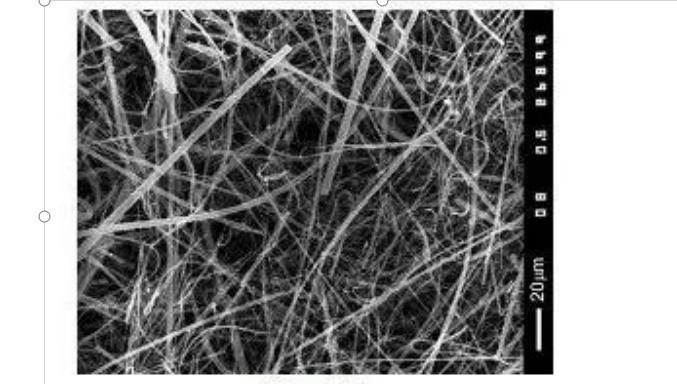AGM separator and transfer reaction between positive and negative plates
Structure and function of partitions
The AGM partitions used by
VRLA have the following additional functions:
Absorb the electrolyte (the third active substance of the battery) so that it does not flow. Provides a relatively large gas transfer hole for oxygen diffusion and thus facilitates the operation of the COC.
High ionic conductivity is guaranteed. Provide a transport channel for the ion current, so that it can be transmitted between the two types of plates, so that the REDOX reaction can be carried out quickly.
Limit the volume expansion of PAM, maintain the polar group pressure, and minimize the pulsation effect of the positive active material during the cycle.
Scanning electron microscopy (SEM) images of AGM separator samples are presented. As can be seen from the figure, the AGM separator is composed of chemically graded borosilicate glass fibers, which are 1 to 2mm in length and vary in thickness (0.1 to 10μm in diameter). The ratio of different fibers determines the balance between the different functions of the separator and the price of the separator. These fibers are hydrophilic and absorb the electrolyte. The finer fibers in the separator (i.e., those with smaller diameters) have a larger surface area and form micropores with smaller inner diameters, but are more expensive. AGM partitions also contain 15-18% PP, PE and other polymer fibers, which improve the mechanical strength of the partition, and promote the formation of gas channels (because these materials are partially hydrophobic), but also reduce the price of the partition. The production process of the AGM separator is similar to that of the papermaking process, making it an anisotropic structure. Its structural feature is that the pore size of the x-y plane of the partition is 2-4 μm, while the size of the pores perpendicular to the x-y plane is 10-30 μm[27]. The function of the X-y plane holes is to distribute the electrolyte in the direction of the thickness of the separator and maintain its core absorption rate when the separator is partially filled with electrolyte. Large holes form open gas channels.

Gas transmission through the AGM separator
After the oxygen precipitates from the positive plate, it is transferred to the negative plate, and then the reduction reaction occurs on the negative plate. The whole oxygen transmission process goes through the following stages.
First, oxygen forms tiny bubbles in the PAM micropores filled with electrolyte. These tiny bubbles then gradually coalesce into discrete bubbles, which gradually replace the electrolyte in the plate micropores towards the separator. A small portion of the oxygen in the bubbles that reach the surface of the plate is dissolved in the electrolyte, while most of the gaseous oxygen remains in the form of bubbles at the plate/separator interface. The AGM separator is a non-uniform structure, so oxygen accumulates in areas with low fiber density on the AGM surface (loose structure) or in some vacant areas between the plate and the separator (tubular electrode /AGM).
Applying pressure to the polar group can make the contact between the surface of the glass fiber and the surface of the plate closer, promoting oxygen penetration of the separator. There are two possible reaction mechanisms:
1. When the polar group pressure is low, the volume of gas accumulated at the plate /AGM separator interface increases. Under the influence of gravity, the air flow will rise vertically. The electrolyte is twice as dense as the gas, pushing the gas upward into the upper space of the polar group. In this way, oxygen will leave the polar group. The vertical gas flow rate depends on the current passing through the battery, the electrolyte temperature, and the state of the battery (such as a new battery or a long-used battery).
2. When the polar group pressure is high, the baffle tightly presses the plate, and the bubbles enter the baffle. The bubbles move horizontally, trying to increase the gas channel in the partition. The density of the glass fiber material structure is uneven, and the bubbles enter the parts with low fiber density. The bubbles move not only randomly, but also parallel to and in a direction perpendicular to the surface of the separator. However, the air flow mainly moves through the AGM separator towards the negative plate with the least gas pressure, and the pressure gradient pushes the oxygen in this direction. Under the action of pressure, the gas replaces the electrolyte in the diaphragm micropores, and thus forms a gas channel. When a continuous gas channel is formed, the movement of oxygen between the positive plate and the negative plate is accelerated.
During the production of AGM partitions for VRLA batteries, the thickness of the partitions is measured at a standard pressure of 10kPa. In order to increase the contact between the plate and the separator, the polar group (the active matter) is compressed, reducing the thickness of the separator by approximately 25%. The pole group of the high stationary battery is secured with a plastic bandage before loading into the battery tank to maintain the pole group pressure.
In summary, the AGM separator is endowed with more functions, which are essential for the AGM battery, no less than the positive plate and the negative plate. The polar group maintains a certain pressure, in addition to achieving oxygen transmission, it is more important to ensure the conductivity of the separator. More on this in subsequent tweets.

